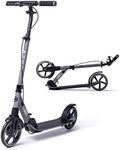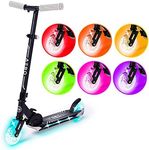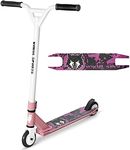Buying Guide for the Best Scooters For Kids
Choosing a scooter for kids can be a fun experience, but it's important to focus on safety, comfort, and how well the scooter matches your child's age and skill level. Start by thinking about where your child will use the scooter—on sidewalks, in parks, or just around the neighborhood. Also, consider how much experience your child has with riding scooters, as this will help you decide on the right features. Always remember that a good fit will make riding more enjoyable and safer for your child.Wheel SizeWheel size refers to the diameter of the scooter's wheels, usually measured in millimeters. This is important because it affects how smooth the ride is and how easy it is to control the scooter. Smaller wheels (around 100-120mm) are lighter and make the scooter easier to maneuver, which is great for younger kids or beginners. Larger wheels (125mm and above) roll more smoothly over bumps and cracks, making them better for older kids or those who want to ride longer distances. Think about your child's age and where they will ride most often—smaller wheels for short, smooth rides, and larger wheels for rougher surfaces or longer trips.
Handlebar HeightHandlebar height is how high the handlebars are from the ground, and it's crucial for comfort and control. If the handlebars are too low or too high, your child might have trouble steering or could get tired quickly. Many scooters have adjustable handlebars, which is ideal because you can set them to match your child's height as they grow. As a rule of thumb, the handlebars should be about waist-high when your child is standing on the scooter. Always check if the scooter can be adjusted to fit your child now and as they get taller.
Deck SizeThe deck is the part of the scooter where your child stands. Deck size matters because it affects balance and comfort. A wider and longer deck gives more space for your child to stand and shift their feet, which is helpful for beginners or younger kids who need extra stability. Narrower decks are lighter and easier to handle, which might suit older or more experienced riders. Consider your child's shoe size and skill level—choose a bigger deck for more stability, or a smaller one for easier tricks and faster riding.
Weight LimitThe weight limit tells you the maximum weight the scooter can safely support. This is important for safety and durability. Scooters with higher weight limits are usually built stronger and can last longer as your child grows. Make sure to check your child's current weight and pick a scooter that can handle a bit more, so they can use it for a longer time. Never exceed the recommended weight limit, as it can make the scooter unsafe.
Folding MechanismSome scooters can be folded for easy carrying and storage, while others are fixed. A folding mechanism is useful if you need to transport the scooter in a car, store it in a small space, or if your child will carry it themselves. However, folding scooters can sometimes be a bit heavier or have more moving parts. If portability is important for your family, look for a scooter with a simple and sturdy folding system. If the scooter will mostly stay at home or in the garage, a non-folding model might be just fine.
Brake TypeScooters usually have either a rear fender brake (where you step on the back wheel cover) or a hand brake (like on a bicycle). The brake type affects how easy it is for your child to stop safely. Rear fender brakes are simple and common on most kids' scooters, and they're easy for younger children to use. Hand brakes can offer more control, especially for older kids or those riding faster. Think about your child's coordination and confidence—choose a brake system they can use comfortably and safely.


















